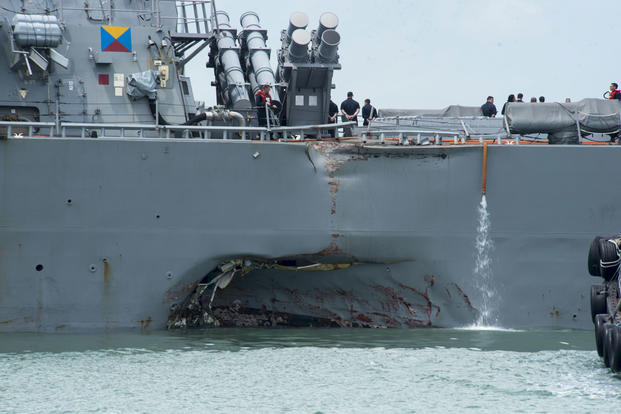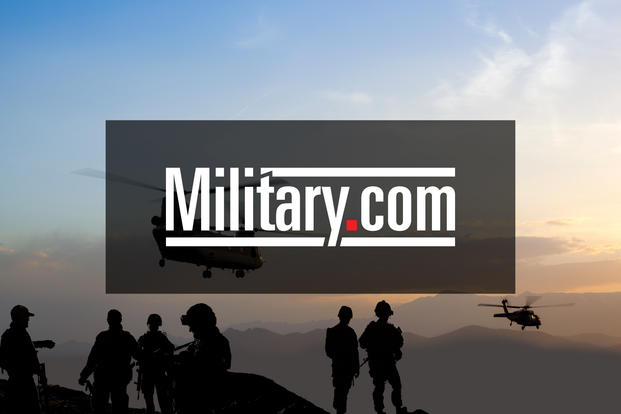U.S. Navy leaders are scrambling for answers after two guided-missile destroyers collided with other ships in the Pacific within months of each other, causing millions in damage and costing the lives of sailors aboard.
In a year that also saw a cruiser run aground in Tokyo Bay and another overrun a South Korean fishing vessel, the evidence appears stark that something is wrong.
Early Wednesday morning, Navy officials announced that the three-star commander of the Yokosuka, Japan-based 7th Fleet, Vice Adm. Joseph Aucoin, had been relieved from his post weeks before his planned retirement in the wake of the mishaps. But is the problem regionally focused, or does it have implications for the larger Navy?
Ongoing investigations into the two recent collisions and a separate review of Navy training and certification standards, with an emphasis on the surface warfare officer community, aim to answer those questions. But some Navy experts who spoke with Military.com suggested the service may not like what it finds out.
Too Small? Too Busy?
For some, the recent disasters provide a robust argument for the significantly larger fleet size that Navy leadership has endorsed. As of today, the Navy has 276 deployable battle-force ships; it wants up to 355 to meet the operational demand around the globe. Fewer ships means less time at home for rest and training; crews are therefore operating with greater stress and exhaustion levels.
"The demand signal from our fleet and combatant commanders is not going down for ships," Tom Callender, a senior fellow for defense programs at the Heritage Foundation and former Naval officer who served as the director of capabilities at the office of the under secretary of the Navy for policy.
"The Navy has pushed to provide and answer those requests as much as possible," he added. "If you look at the number of ships you have deployed, it's been pretty constant at about 100 ships, even as you've taken about a 20 percent decrease in fleet size. Something has to give there."
Related content:
- Navy Dismisses 7th Fleet Commander After Warship Accidents
- Richardson: 'No Indication' USS McCain Collision Due to Foul Play
- CNO Orders Operational Pause, Review After Latest Ship Collision
Rep. Rob Wittman, a Virginia Republican and the chairman of the House Armed Services Committee's panel on Seapower and Projection Forces, released a forceful statement blaming the stressors on the fleet for the recent accidents.
"While I support the chief of Naval Operations' operational safety stand down of the fleet, I believe that there are even more basic causes for this systematic operational failure of our fleet to include a demanding operational tempo, limited training opportunities and inadequate funding to support basic needs," Wittman said. "I look forward to conducting a detailed review of ongoing Navy operations to ensure the basic safety of our sailors and sufficient forces for our national security."
But that explanation doesn't wash for everyone.
Despite the fact that all four ships involved in recent mishaps were operating in regions with some of the highest sea traffic in the world, they ran afoul during routine transits and operations.
The commanding officer of U.S. Pacific Fleet, Adm. Scott Swift, said in a message to the fleet that the disasters took place during "the most basic of operations," suggesting complacency and a casual approach to ship operations was the true culprit.
"I'm disappointed in a few people who are using this as as a reason that we need a bigger Navy; that's tertiary," said another retired Navy officer and popular military blogger who goes by the pen name CDR Salamander. "We have a high op-tempo, but that's no excuse. This is a Vince Lombardi Navy: 'See that ship? Don't let another ship hit it.'" Lombardi was a famous football player and coach.
Pacific Challenges
The fact that all recent mishaps have taken place in the same region, under the same Navy fleet command, does raise questions about the challenges and dangers of operating in the 7th Fleet.
The two Navy destroyers that collided with commercial vessels, the USS John S. McCain and the USS Fitzgerald, and a cruiser that ran aground in Tokyo Bay, the USS Antietam, are home-ported in Yokosuka and maintain a constant forward-deployed presence in the Pacific.
In 2015, a Government Accountability Office report showed that these forward-based ships, moved to the region in a broad Navy strategy to increase Pacific presence, spend significantly more time deployed and were regularly short-changed on training.
The report showed that U.S.-based cruisers and destroyers spent roughly 40 percent of their time deployed and 60 percent in training and maintenance periods, while their Japan-based counterparts spent 67 percent of their time deployed, 33 percent in maintenance, and did not have a dedicated training period.
The report's authors wrote that this led to a "train on the margins" approach in which crews squeezed in training while underway or whenever possible between underway periods. In addition, a GAO survey at the time found up to 17 percent of warfare certifications for crews home-ported in Japan were expired, and some had been for months.
Jerry Hendrix, a senior fellow at the Center for a New American Security and retired Navy captain who served on the chief of Naval Operations' executive panel, told Military.com the geography of the region also presented its own challenges.
The Strait of Malacca where the McCain had just transited through en route to Singapore before colliding with a Liberian-flagged tanker Monday morning, is the most highly-trafficked strait in the world, Hendrix noted. The volume of traffic, he said, added to the complexity of moving through the narrow strait.
But a more persistent factor, he said, may be the greater distances and lengthy at-sea periods that come with Pacific operations.
"The distances are much greater, so I think there's a higher degree of exhaustion that's associated with operating in the Western Pacific," Hendrix said.
He noted too, that it has been a long time since sailors in the Pacific were commanded by a surface warfare officer, who might be more instinctively attuned to the surface fleet's training and operational needs. Aucoin, who was just relieved, is a naval aviator; Swift, the Pacific Fleet commander, is as well.
PacFleet had its last SWO commander, Adm. Gary Roughead, from 2005-2007; the 7th Fleet saw its last SWO commander, Vice Adm. William Crowder, from 2006-2008.
"While we like to pretend that all our admirals are the same, each admiral brings their own area of community expertise," Hendrix said. "There's a question as to how long has it been since a senior SWO looked at procedures in the region. My question to CNO-level management of detailing people is, 'When was the last time you thought about that rotation and how important it is?'"
Training Shortfalls
For the Navy, the most uncomfortable revelations may come as the service examines the state of surface warfare officer training and pre-deployment certification training today, and whether crews are missing the mark at sea.
To be clear, recent events have highlighted these crews' ability to respond magnificently to a crisis, acting with heroism and efficiency. Partial investigation findings released last week from the destroyer Fitzgerald's collision with a Philippine-flagged container ship southwest of Tokyo in June detail the heroism of crew members who worked tirelessly to save those trapped in flooding berthing spaces and guard against more damage to their hobbled ship. Seven sailors perished in the disaster, but the number could have been greater had the crew not acted as it did.
In a press conference in Singapore Tuesday, Swift also praised the crew of the McCain, which began launching search-and-rescue aircraft for ten missing sailors shortly after sustaining significant damage in the collision.
Regardless, the fact of the collisions is evidence of something gone badly wrong. Multiple experts who spoke with Military.com said in the case of the McCain, as it exited a congested strait and prepared to enter port, it was likely that a sea-and-anchor detail -- additional manning -- had been on station to ensure safe transit and that a senior officer was on the bridge to supervise.
Salamander recalled the 2007 incident when the destroyer USS Arleigh Burke ran aground at the entrance to the Chesapeake Bay in daylight because the navigational system had an input error and no one had looked out the window to confirm the ship's position.
"There's no bad computer bad radar that's going to substitute for you not looking out the bloody window," he said.
Callender noted that ships have a high annual turnover -- about 100 of a destroyer's roughly 300 sailors will be new to the ship every year -- and it was crucial that developing proficiency in the basics, and maintaining that proficiency, be given priority. And simulators, while advanced, can't replicate the pressures and requirements of real-world navigation.
"It's like first getting your driver's license. It's not the same as being a driver who's driven for ten years," he said. "... There's a demand and a need, I don't care how senior you are, to do that refresher training on a monthly, annual basis, to review the procedures."
In addition to the challenge of green crews, Salamander said he believes "perverse career incentives" to get command tours elsewhere can result in fewer and shorter at-sea periods for surface warfare officers.
And while Chief of Naval Operations Adm. John Richardson has said the Navy's new review of practices will include external input from other military services and industry, Salamander suggested looking to the navies of other nations, including the United Kingdom and the Netherlands, which also sail around the globe but appear to maintain lower major mishap rates than the U.S. Navy does.
Internationally, he said, some ships give a wide berth to U.S. Navy vessels, which are developing a reputation for sloppy sailing that is only validated by recent mishaps.
"This would require a culture change, a career change, a training change," Salamander said. "It would require us to take a deep breath and say, 'We may be the world's largest Navy, but we are not the best Navy.'"
-- Hope Hodge Seck can be reached at hope.seck@military.com. Follow her on Twitter at @HopeSeck.
Related Video:
The guided-missile destroyer USS John S. McCain (DDG 56) arrives pier side at Changi Naval Base, Republic of Singapore following a collision with the merchant vessel Alnic MC while underway east of the Straits of Malacca and Singapore.





























